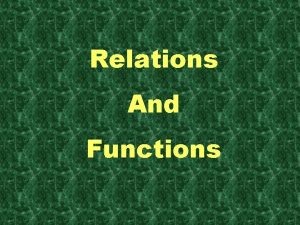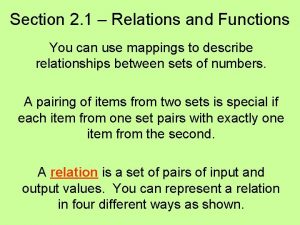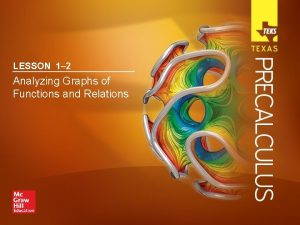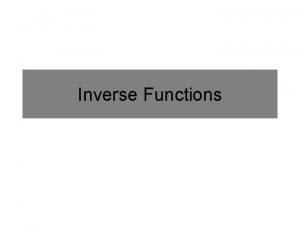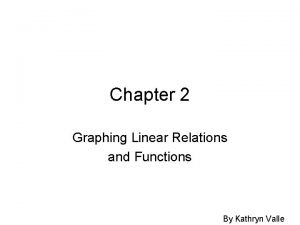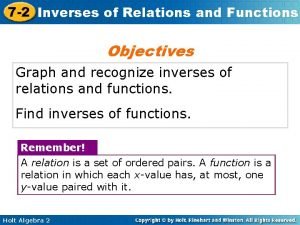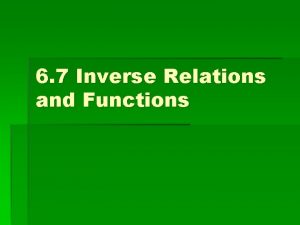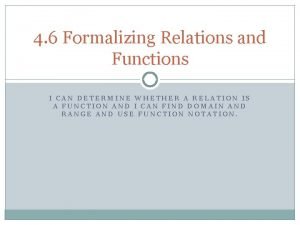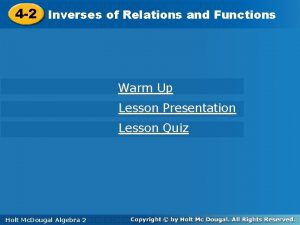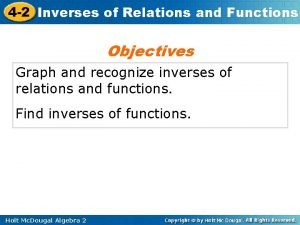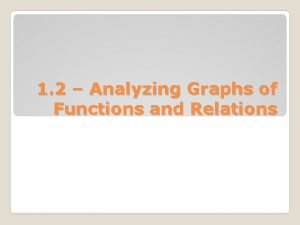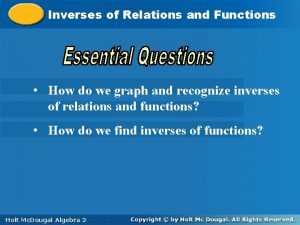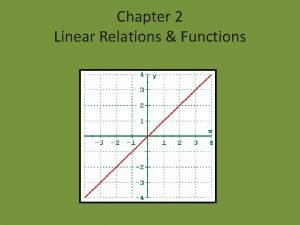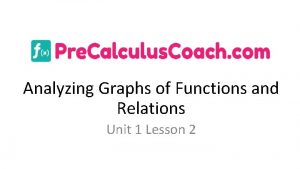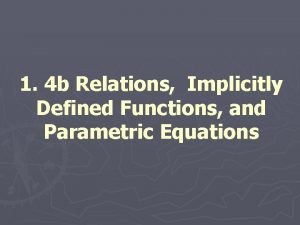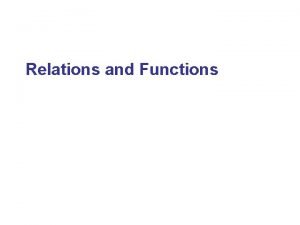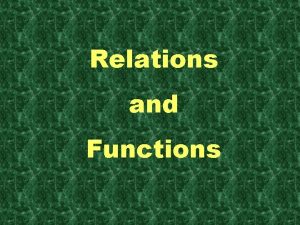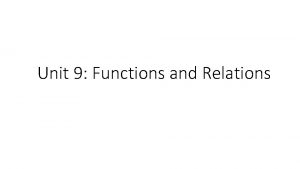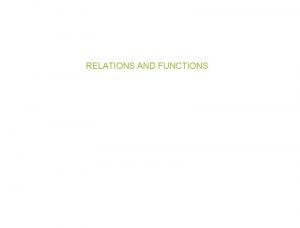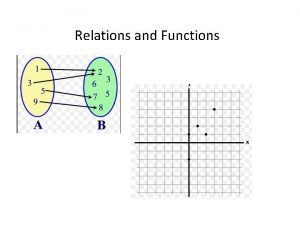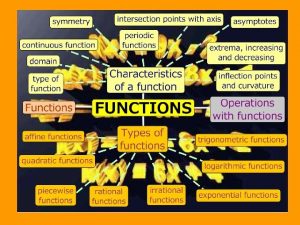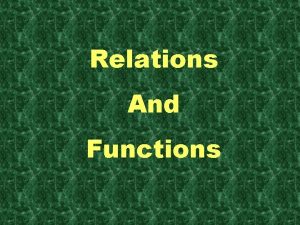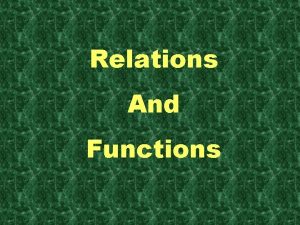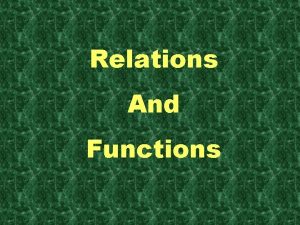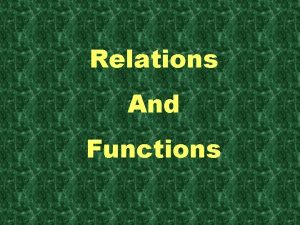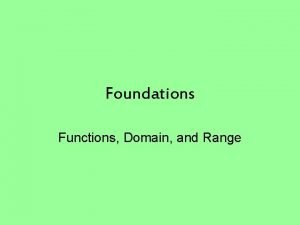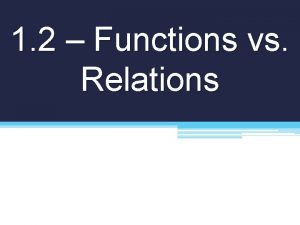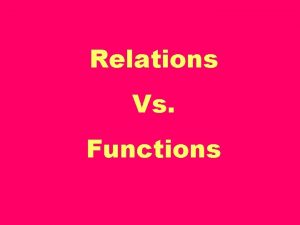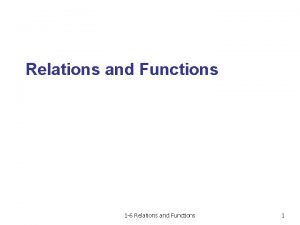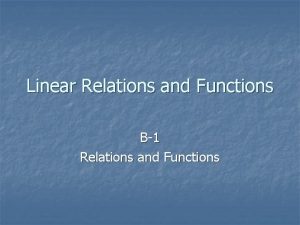Relations And Functions A relation is a set


















- Slides: 18

Relations And Functions

A relation is a set of ordered pairs. The domain is the set of all x values in the relation domain = {-1, 0, 2, 4, 9} These are the x values written in a set from smallest to largest {(2, 3), (-1, 5), (4, -2), (9, 9), (0, -6)} These are the y values written in a set from smallest to largest range = {-6, -2, 3, 5, 9} The range is the set of all y values in the relation This is a relation

A relation assigns the x’s with y’s 1 2 3 2 4 5 6 8 10 Domain (set of all x’s) Range (set of all y’s) 4 This relation can be written {(1, 6), (2, 2), (3, 4), (4, 8), (5, 10)}

AAfunction fffromset set. AAto toset set. BBisisaaruleof ofcorrespondence thatassignsto toeachelement xxin inthe theset set. AA exactly one elementyyin inthe theset set. B. B. e r a s ’ ll x gned A si as 1 2 3 4 5 2 4 6 8 10 Set A is the domain This is a Whew! What function did that say? ---it meets our conditions No x tha has m ass n one ore ign y ed Set B is the range Must use all the x’s The x value can only be assigned to one y

Let’s look at another relation and decide if it is a function. The secondition says each x can have only one y, but it CAN be the same y as another x gets assigned to. e r a s ’ ll x gned A si as 1 2 3 4 5 2 4 6 8 10 Set A is the domain This is a function ---it meets our conditions No x tha has m ass n one ore ign y ed Set B is the range Must use all the x’s The x value can only be assigned to one y

goodexamplethatyou youcan can“relate”totoisisstudentsininour AAgood mathsclassthissemesterare areset set. A. A. Thegradetheyearnout maths theclassisisset set. B. B. Eachstudentmustbe beassignedaagrade ofofthe andcan canonly be be assigned ONE and ONE grade, butmorethanone studentcan canget getthe thesamegrade(we (wehopeso---wewantlotsofof student A’s). Theexampleshown show on the previous screen had each A’s). studentgettingthe thesamegrade. That’sokay. student 1 2 3 4 5 2 4 6 8 10 2 was assigned both 4 and 10 Is the relation shown above a function? NO Why not? ? ?

Check this relation out to determine if it is a function. It is not---3 didn’t get assigned to anything Comparing to our example, a student in maths must receive a grade 1 2 3 4 5 Set A is the domain 2 4 6 8 10 Set B is the range This is not a Must use all the x’s function---it doesn’t assign each x with a y The x value can only be assigned to one y

Check this relation out to determine if it is a function. This is fine—each student gets only one grade. More than one can get an A and I don’t have to give any D’s (so all y’s don’t need to be used). 1 2 3 4 5 2 4 6 8 10 Set A is the domain This is a function Set B is the range Must use all the x’s The x value can only be assigned to one y

We commonly call functions by letters. Because function starts with f, it is a commonly used letter to refer to functions. This means the right hand side is a function called f This means the right hand side has the variable x in it The left side DOES NOT MEAN f times x like brackets usually do, it simply tells us what is on the right hand side. The left hand side of this equation is the function notation. It tells us two things. We called the function f and the variable in the function is x.

Remember---this tells you what is on the right hand side---it is not something you work. It says that the right hand side is the function f and it has x in it. So we have a function called f that has the variable x in it. Using function notation we could then ask the following: This means to find the function f and instead of having an x in it, put a 2 in it. So let’s take the Find f (2). function above and make brackets everywhere the x was and in its place, put in a 2. Don’t forget order of operations---powers, then multiplication, finally addition & subtraction

Find f (-2). This means to find the function f and instead of having an x in it, put a -2 in it. So let’s take the function above and make brackets everywhere the x was and in its place, put in a -2. Don’t forget order of operations---powers, then multiplication, finally addition & subtraction

Find f (k). This means to find the function f and instead of having an x in it, put a k in it. So let’s take the function above and make brackets everywhere the x was and in its place, put in a k. Don’t forget order of operations---powers, then multiplication, finally addition & subtraction

Find f (2 k). This means to find the function f and instead of having an x in it, put a 2 k in it. So let’s take the function above and make brackets everywhere the x was and in its place, put in a 2 k. Don’t forget order of operations---powers, then multiplication, finally addition & subtraction

Let's try a new function Find g(1)+ g(-4).

The last thing we need to learn about functions for this section is something about their domain. Recall domain meant "Set A" which is the set of values you plug in for x. For the functions we will be dealing with, there are two "illegals": 1. You can't divide by zero (denominator (bottom) of a fraction can't be zero) 2. You can't take the square root (or even root) of a negative number When you are asked to find the domain of a function, you can use any value for x as long as the value won't create an "illegal" situation.

Find the domain for the following functions: Since no matter what value you choose for x, you won't be dividing by zero or square rooting a negative number, you can use anything you Note: There is want so we say the answer is: nothing wrong with the top = 0 just means All real numbers x. the fraction = 0 illegal if this is zero If you choose x = 2, the denominator will be 2 – 2 = 0 which is illegal because you can't divide by zero. The answer then is: All real numbers x such that x ≠ 2. means does not equal

Let's find the domain of another one: Can't be negative so must be ≥ 0 solve this We have to be careful what x's we use so that the second "illegal" of square rooting a negative doesn't happen. This means the "stuff" under the square root must be greater than or equal to zero (maths way of saying "not negative").

Summary of How to Find the Domain of a Function • Look for any fractions or square roots that could cause one of the two "illegals" to happen. If there aren't any, then the domain is All real numbers x. • If there are fractions, figure out what values would make the bottom equal zero and those are the values you can't use. The answer would be: All real numbers x such that x ≠ those values. • If there is a square root, the "stuff" under the square root cannot be negative so set the stuff ≥ 0 and solve. Then answer would be: All real numbers x such that x is defined by whatever you got when you solved. NOTE: Of course your variable doesn't have to be x, can be whatever is in the problem.
 Total set awareness set consideration set
Total set awareness set consideration set Training set validation set test set
Training set validation set test set Employee relations in public relations
Employee relations in public relations A set of x's from the relation
A set of x's from the relation Relations and functions
Relations and functions Lesson 1 analyzing a graph
Lesson 1 analyzing a graph Inverse relations and functions
Inverse relations and functions 2-2 practice linearity and symmetry
2-2 practice linearity and symmetry 7-2 inverses of relations and functions
7-2 inverses of relations and functions Inverse variation graph calculator
Inverse variation graph calculator Unit 5 lesson 6 formalizing relations and functions
Unit 5 lesson 6 formalizing relations and functions Lesson 4-2 practice a inverses of relations and functions
Lesson 4-2 practice a inverses of relations and functions 4-2 inverses of relations and functions
4-2 inverses of relations and functions 1-2 analyzing graphs of functions and relations
1-2 analyzing graphs of functions and relations 4-2 practice b inverses of relations and functions
4-2 practice b inverses of relations and functions 2-2 linear relations and functions
2-2 linear relations and functions Analyzing graphs of functions
Analyzing graphs of functions Find two functions defined implicitly by the given relation
Find two functions defined implicitly by the given relation Relation vs function
Relation vs function



